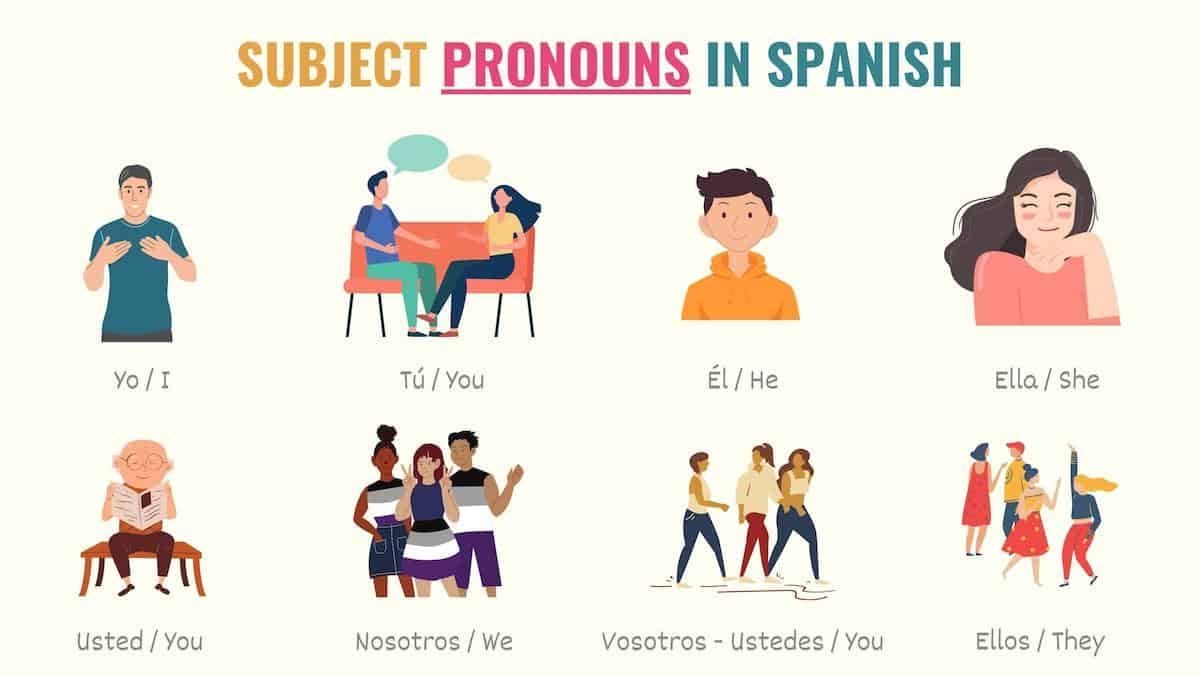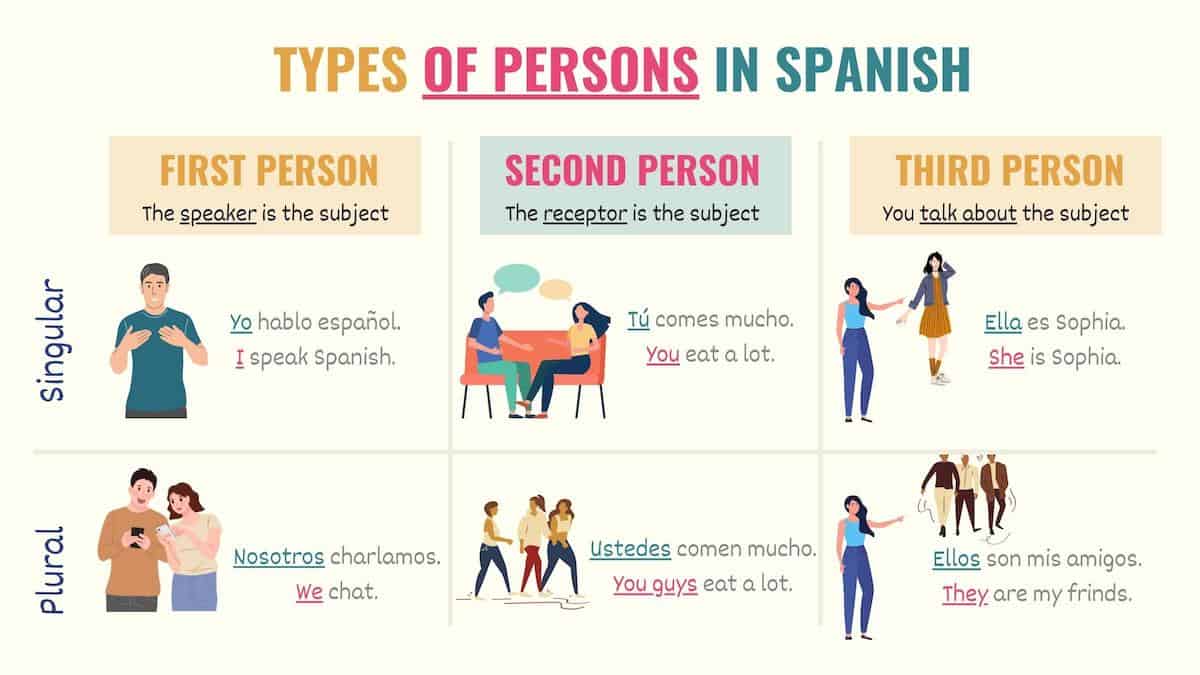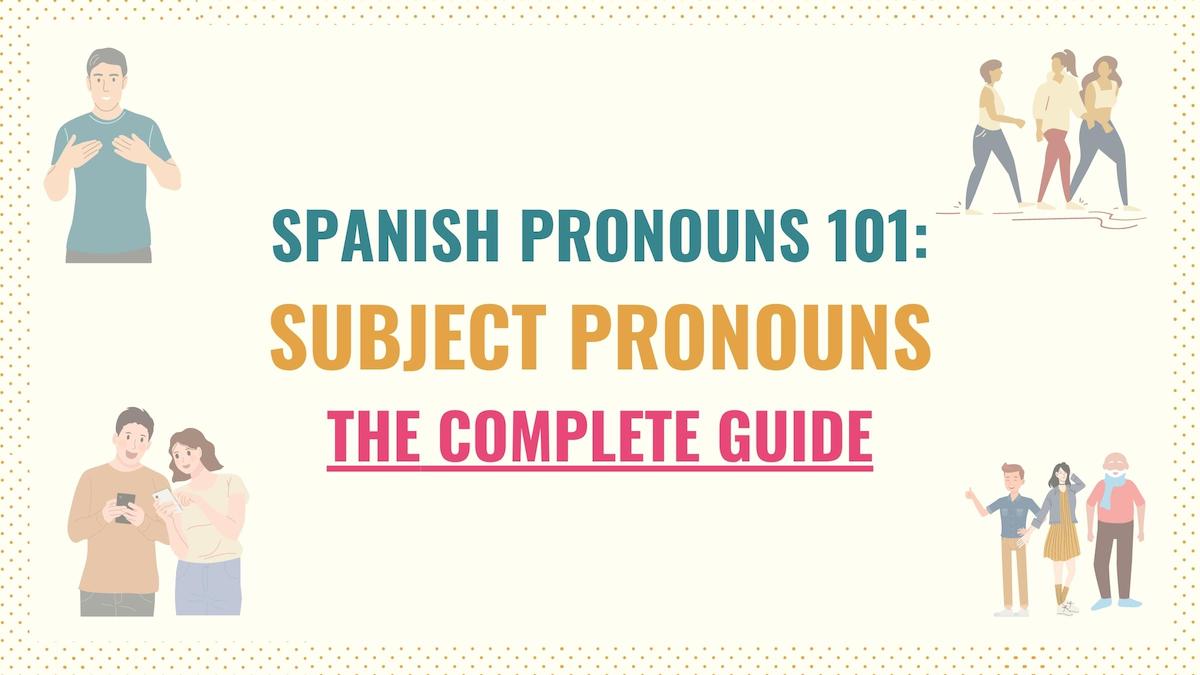Even if grammar is not your cup of tea, you’ve probably already heard about Spanish subject pronouns. And why should you care about these words? Because they communicate who does an action in a short, non-repetitive manner.
In essence, these words are fundamental! With that in mind, in this article, I’ll provide you with all the key information you need to understand these Spanish pronouns.
The things you’ll learn throughout this lesson are:
- Subject Pronouns in Spanish List
- When to Use (and Not Use) Subject Pronouns in Spanish
- Are Spanish Personal & Subject Pronouns the Same?
- Key Points
- Downloadable PDF
Spanish Subject Pronouns Chart
There are thirteen subject pronouns in Spanish. These pronouns are classified into singular and plural based on the number of people they refer to.
Singular Subject Pronouns
- Yo – I
- Tú (informal) – You
- Vos (informal)* – You
- Él – He
- Ella – She
- Usted (formal) – You
Plural Subject Pronouns
- Nosotros / Nosotras – We
- Vosotros / Vosotras (Spain) – You
- Ellos / Ellas – They
- Ustedes – You
Take Note: Keep in mind that, in Latin America, the pronoun vosotros is never used. Instead, some countries use vos as an informal way to say ‘you’. This subject pronoun is only used in Argentina, Paraguay, El Salvador, Costa Rica, Chile, and some regions of Bolivia.

Even though they have the same translation, there’s a clear distinction between tú, vos, and usted. Tú and vos are informal ‘you’ pronouns, meaning that we use them with family and friends.
‘Usted’, on the other hand, is formal Spanish. We use this pronoun to respectfully address elderly people or those with a higher position than us. Some examples include teachers, bosses, and seniors.
Take Note: Now that you’re getting familiar with subject pronouns, you’ll start hearing about 1st person, 2nd person, and 3rd person. Here’s what these classifications mean:

Tip: Even though ‘usted’ and ‘ustedes’ are used to address people directly, they’re classified as third person because they follow this conjugation pattern.
How & When to Use Spanish Subject Pronouns
A subject pronoun replaces the subject of a sentence. In other words, they replace the person that is performing the action. Using these words prevents you from repeating long nouns while reminding you who is doing the action.
Check these examples below:
Without subject pronouns
María, Joe, Vanessa y sus primos hablan inglés.
María, Joe, Vanessa, and her cousins speak English.
Claudia, Sally y yo trabajamos todo el día.
Claudia, Sally and I work all day.
With subject pronouns
Ellos hablan inglés.
They speak English.
Nosotras trabajamos todo el día.
We work all day.
Pronouns like él, nosotros, and vosotros have a feminine form. However, the rest of the pronouns have a single form. With these single form pronouns, you must rely on the context or use Spanish adjectives if you need to indicate the gender of a noun.
Yo soy maestra.
I’m a teacher.
Tú eres muy alta.
You’re very tall.
Usted es muy gracioso.
You’re very funny.
Unlike English, you don’t need to use Spanish subject pronouns all the time. In fact, the ending of a conjugated verb, conveys who the subject is.
So, by looking at the conjugation of the verb below, I know it’s you who is doing the action:
¡Comes un montón!
You eat a lot!
The situations where your sentence actually needs to use a subject pronouns are:
- To emphasize the subject
- To clarify who the subject is when conjugations are similar
- To avoid repeating the verb
Let’s take a look at examples for each situation so you know when to use them.
To emphasize the subject
Mira, ella es la maestra. Haz lo que dice.
Look, she’s the teacher. So, do what she says.
To clarify who the subject is when Spanish conjugations are similar:
Yo jugaba con mi prima.
I played with my cousin.
Ella jugaba con su perro.
She played with her dog.
Some Spanish tenses, like the conditional and imperfect tenses, share the same endings for different subjects (yo, él, etc.). Therefore, adding the subject pronoun is necessary to clarify who is performing the action.
To avoid repeating the verb
Sonia tiene veinte años y yo quince.
Sonia is twenty years old, and I am fifteen.
By adding the subject pronoun (yo), we can avoid repeating the verb (tiene) that was used, since we’re describing the same thing (a person’s age) for both subjects.
Spanish Pronouns: Personal Pronoun vs Subject Pronoun
Do you think personal pronouns and subject pronouns are the same? If you said yes, don’t feel bad, this is a common mistake. In fact, I’ve seen other articles and teachers treat them the same. They’re not.
What are Subject Pronouns?
As mentioned before, subject pronouns are pronouns that we use to replace the subject of a sentence. Unlike other personal pronouns, subject pronouns are not mandatory since Spanish conjugations can help you identify who the subject of a sentence is.
What are Personal Pronouns?
Spanish personal pronouns are pronouns that we use to replace a person, thing, or place based on their function within a sentence. They’re called personal because they must agree in number and gender with the noun they’re replacing.
As you’re about to learn, subject pronouns are a type of personal pronoun.
Types of personal pronouns
Personal pronouns in Spanish are:
- Subject pronouns
- Reflexive pronouns
- Direct object pronouns
- Indirect object pronouns
- Prepositional pronouns
Determining which type of pronoun to use depends on the elements of your sentence.
Take Note: Every subject pronoun has their own object pronouns (direct, reflexive, indirect). However, object pronouns do not replace the person performing the action, but rather the person or thing receiving it.
Key Points
Spanish subject pronouns are crucial to building coherent sentences. So don’t underestimate their importance! Here are some key points to remember:
- A subject pronoun replaces the (subject) person or thing performing the action of a sentence.
- Subject pronouns in Spanish are:
- Yo – I
- Tú – You
- Usted – You
- Él – He
- Ella – She
- Nosotros – We
- Vosotros – You (plural)
- Ellos / Ellas – They
- Ustedes – You (plural)
- ‘Tú’ is the informal version of ‘you’, while ‘usted’ is the formal term.
- Since conjugated Spanish verbs indicate who the subject is, subject pronouns are often dropped from sentences.
- Subject pronouns in Spanish must be included in sentences for tenses that share the same verb conjugations (i.e. imperfect and conditional).
- Spanish personal pronouns are not the same as subject pronouns. Personal pronouns replace nouns with different functions. Subject pronouns are a subset of personal pronouns.
- Based on their function in a sentence, Spanish personal pronouns are classified as:
Download the Subject Pronouns Spanish PDF Cheat Sheets
Download a copy of the PDF cheat sheet containing all the highlights, graphics and key points for this guide as well as links to related articles and next steps to take in learning the fundamentals of Spanish grammar.



